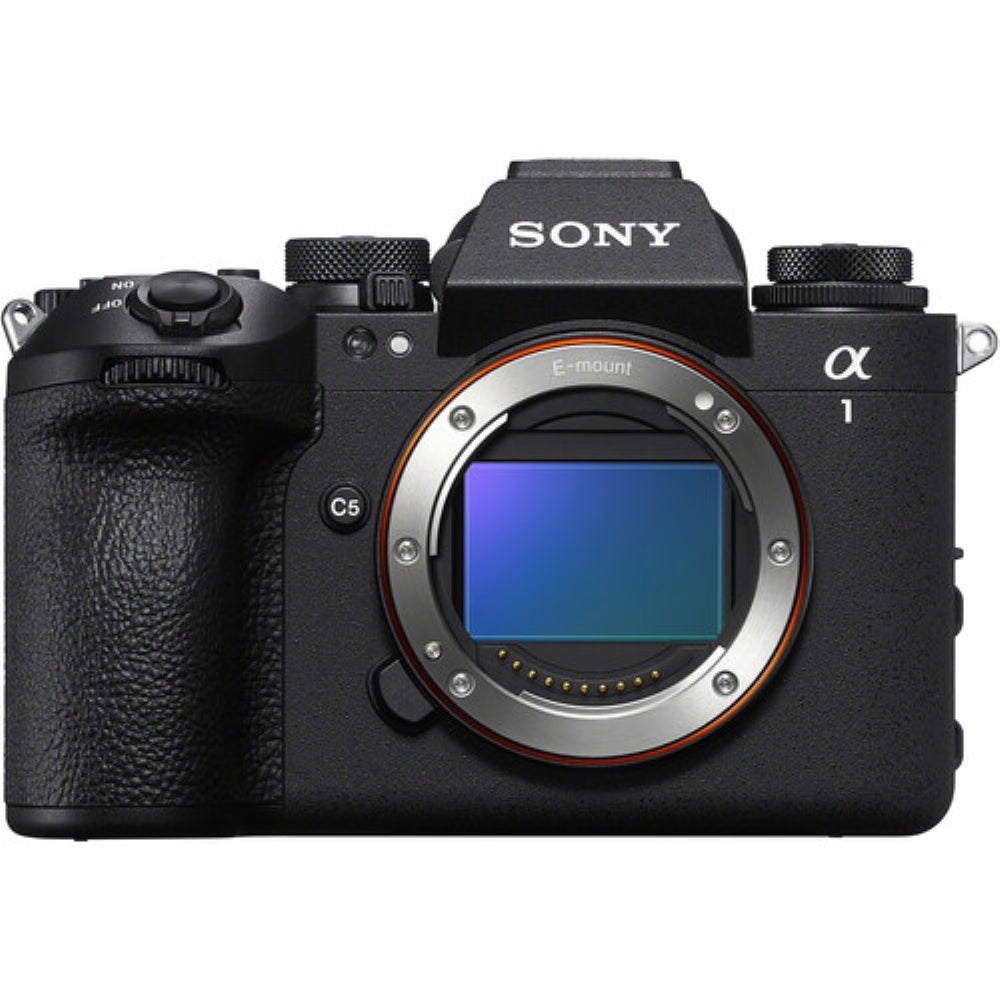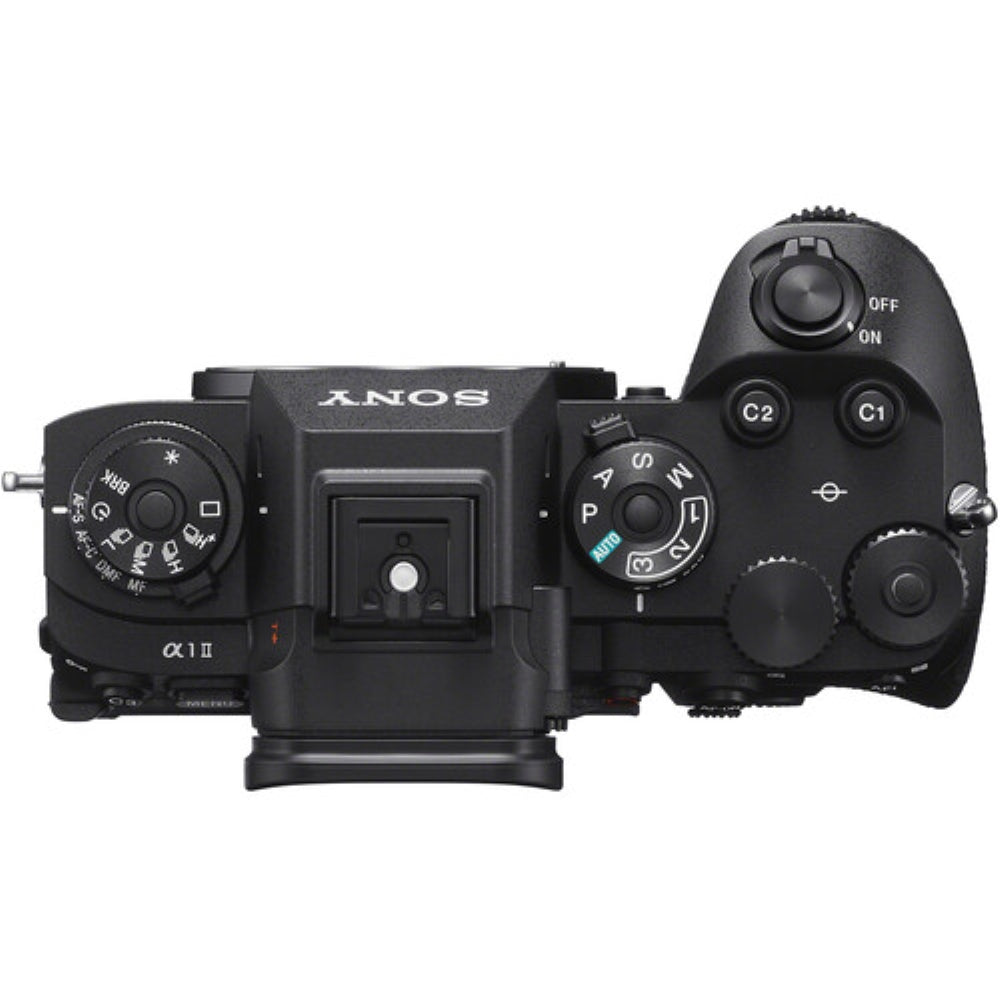









Sony a1 II Mirrorless Camera
Sony a1 II Mirrorless Camera
STORE
54 Orchard Street
Ground Floor
New York NY 10002
United States
The Sony a1 II represents the pinnacle of versatility in their camera lineup, delivering an exceptional combination of speed, video functionality, high-resolution imagery, and a durable, professional-grade design. It integrates many of the well-balanced features from the original a1 into the body of the a9 III, while also incorporating the autofocus and in-body image stabilization technologies introduced with the a7R V. This camera is tailored for working professionals across various fields, including sports, editorial, product, fashion, and advertising photography, while also appealing to landscape, portrait, wedding, and event photographers. Additionally, it offers the advanced video capabilities characteristic of the a1 series, such as 8K recording, along with effective stabilization and framing tools derived from the ZV series.
The a1 II consolidates Sony's leading technologies from all its camera lines into a single, comprehensive body, establishing it as the ultimate all-in-one solution for professional photographers.
 The Integration Of Advanced Technologies Results In Exceptional Performance
The Integration Of Advanced Technologies Results In Exceptional Performance
The massive volume of data generated by the approximately 50.1 effective megapixel full-frame Exmor RS™ image sensor is processed instantaneously by Sony’s BIONZ XR™ image processing engine. An advanced AI processing unit employs sophisticated subject recognition capabilities to accurately identify a diverse array of subjects. These cutting-edge technologies work in unison to facilitate the capture of even the most difficult subjects in remarkable resolution, featuring blackout-free viewing and comprehensive AF/AE tracking performance at speeds of up to 30 frames per second.
The α1 II is equipped with a specialized AI processing unit that enhances the accuracy of human recognition through advanced pose estimation techniques. Additionally, it is capable of identifying a diverse array of subjects beyond humans, including animals, vehicles, and insects, with remarkable precision. This advancement significantly elevates the performance of Real-time Recognition AF and Real-time Tracking, leading to an overall enhancement in autofocus capabilities.
Experience Netflix from a fresh perspective. The Netflix Adaptive Calibrated Mode, developed collaboratively by Sony and Netflix, delivers studio-quality mastering to your home, with brightness levels automatically tailored to the lighting conditions of your environment.
Smarter, Faster Autofocus and Subject Tracking

The focusing system of the a1 II has undergone substantial enhancements compared to its predecessor, now featuring an AI Processing Unit along with improved subject detection and tracking capabilities. The phase-detection autofocus system continues to utilize 759 points, which encompass approximately 92% of the sensor area, enabling focusing down to -4 EV at f/2. Additionally, advancements in subject tracking and detection have been made, with the camera demonstrating a 30% increase in speed for detecting human eyes and a 50% increase for animal eyes.
- First seen in the a7R V and a9 III, the a1 II sports a dedicated AI Processing Unit for refined, responsive, and intelligent subject tracking and detection of humans, animals, birds, insects, cars, trains, and airplanes.
- Human pose estimation tracks body and head positions for accurate focus in portraiture and sports settings and Real-time Eye AF performance has been improved by 30%.
- Additionally, human pose estimation can distinguish between multiple people and maintain focus on the targeted subject; even if someone crosses in front, the camera maintains focus on the key person.
- Real-time Tracking benefits from AI-based subject recognition for following moving subjects, making it particularly well-suited to sports and action subjects.
- Auto Subject Recognition modes no longer necessitate selecting a subject type, letting the camera detect and track the intended subject.
- XS and XL focus area spot sizes have been added for more subject versatility or you can customize AF focus areas to suit uniquely sized or shaped subjects.
- Full-time DMF (Direct Manual Focus) enables using the lens's focus ring for manual focus control at any time, making it easier to switch focus to a different subject even when working with AF.
Sensor and Processing
The initial a1 model was recognized for its exceptional imaging capabilities, and the a1 II enhances this with advanced BIONZ XR processing, an AI processing unit, a more robust 8.5-stop in-body image stabilization (IBIS), and the remarkable 50MP stacked BSI CMOS sensor inherited from its predecessor. This combination of sensor and processor enables a maximum shooting rate of 30 frames per second, an extended sensitivity range from ISO 50 to 102400, and an impressive dynamic range of 15 stops. Furthermore, in terms of speed, the a1 II introduces the Pre-Capture and Speed Boost features that were first introduced with the a9 III.
Continuous shooting is possible at up to 30 frames per second using an electronic shutter, or 10 frames per second with a mechanical shutter, both of which support autofocus (AF) and auto exposure (AE). The Pre-Capture Shooting feature allows for recording at 30 fps for up to one second before the shutter is fully pressed, ensuring that fleeting moments are not missed. The Speed Boost function enables the adjustment of continuous shooting speed during a burst; by pressing the C5 button while shooting in burst mode, users can switch to a faster or slower shooting speed to match the action being captured. The advanced 5-axis in-body image stabilization system effectively compensates for camera shake, providing up to 8.5 stops of stabilization at the center and 7 stops at the edges, representing a 3-stop improvement over the original model. This device utilizes the same full-frame 50MP stacked BSI CMOS sensor as its predecessor, combining high resolution with rapid performance and minimized rolling shutter effects, catering to both detail-oriented and fast-paced photographers.
 Alpha's Alpha in Video Capabilities
Alpha's Alpha in Video Capabilities
The original a1's video specifications were pioneering for its era and, in numerous aspects, remain advanced even today. The a1 II retains many of the fundamental resolutions and frame rates while enhancing its video recording functionalities with additional supportive modes and features. Notably, it includes Dynamic Area Stabilization and offers a genuine 24.00 frame rate for a cinematic appearance, along with timecode input available through an optional adapter. Consequently, the a1 II is equally proficient on a professional film set as it is within a photography studio.
Familiar recording formats include 8K at 30 frames per second with 10-bit 4:2:0 sampling, as well as 4K at 120 frames per second with 10-bit 4:2:2 sampling. When utilizing a Super 35 recording area, 4K footage can benefit from 5.8K oversampling to enhance detail, while the full-frame area provides 8.6K oversampling for 8K footage. The inclusion of the S-Cinetone profile, ProRes RAW output via HDMI, and the capability to import LUTs highlight the extensive color control available with the a1 II. The AI subject recognition feature, powered by the AI Processing Unit, enhances the Framing Stabilizer mode, allowing for automatic cropping and recomposition to keep the subject centered within the frame. Dynamic Active Mode Stabilization further ensures precise framing during filming, particularly when capturing footage while walking or in motion. Additionally, the system supports Breathing Compensation mode, which mitigates the effects of focus breathing when using certain lenses.
Pre-Capture & Speed Boost-Never Miss a Moment
The a1 II not only incorporates the essential technology provided by the sensor but also introduces supplementary features that enhance the camera's overall capabilities.
-
Pre-Capture: The a1 II can be configured to begin recording images to the buffer when the shutter button is half-pressed. Users can set this between 0.03-1.0 second. Upon pressing the shutter these images will be saved to the memory card.
-
Speed Boost: With Speed Boost and the C5 button, which is conveniently placed near the grip on the front of the camera, users can instantly switch their camera from their usual continuous shooting frame rate to a faster one to make sure their next shot is just right. Photographers will be able to select various frame rates up to 30 fps.
 Professional Body Design and Connectivity
Professional Body Design and Connectivity
The a1-series has consistently represented the pinnacle of Sony's offerings, featuring one of the most robust and sophisticated physical designs in the lineup. The a1 II, however, receives enhancements that align it with the a9 III, particularly regarding button configuration, screen and electronic viewfinder integration, and overall durability. This camera is engineered for professional applications and boasts the most resilient and dependable design within Sony's range.
Versatile and Durable Design
- The a1 II features the latest Sony mirrorless body design, initially introduced with the a9 III, which incorporates a C5 custom button on the front and an improved grip for enhanced usability.
- For data transfer, the camera is equipped with an upgraded 2.5GBASE-T wired LAN port, providing increased transfer speeds suitable for demanding tethered shooting scenarios. Additionally, it includes a USB-C port and a full-size HDMI port, with the USB-C port supporting rapid USB 3.2 Gen 2 speeds of up to 10 Gb/s.
- The dual memory card slots are compatible with both CFexpress Type A and SD-type memory cards, offering versatile file management options. This dual-slot configuration allows users to partition file types or utilize it for overflow recording. Furthermore, both slots are rated to support UHS-II memory cards, ensuring faster transfer speeds.
Tru-Finder EVF and Tilting Touchscreen LCD
- An impressive QXGA OLED Tru-Finder EVF features a high 9.44m-dot resolution and 0.9x magnification for exceptionally bright, clear, and detailed eye-level viewing. There is also a 120-fps option that maintains the higher resolution for a better mixture of clarity and motion fluidity.
- 3.2" 2.1m-dot 4-axis multi-angle touchscreen LCD-first seen on the a7R V. This screen has a wide color gamut covering the DCI-P3 space.
- Intuitive menu structure that complements having different workflows with different settings selections for movie recording and stills shooting. The menu system also works in conjunction with the touchscreen design of the rear LCD.
Enhanced Functionality and Usability
Sony has continued to improve the workflows of their professional cameras with upgraded and additional features:
- A voice memo function promises clearer recording with a microphone located close to the user. These memos can be transferred via FTP and can be converted to text using Sony's Transfer & Tagging application.
- IPTC metadata can be automatically added to images and up to 20 presets can be saved.
- Built-in Wi-Fi and Ethernet can be used for fast networked data transfer during shooting.
Composite Shooting Modes
By capturing multiple images and combining them in post-production, users can achieve image quality and resolutions not possible with just the core sensor technology. The a1 II offers two different options for composite shooting:
-
Pixel Shift Multi Shooting: This distinctive compositing mode enables the attainment of a resolution that surpasses the capabilities of the 50.1MP sensor. By collaborating with the sensor-shift image stabilization, this mode shifts the sensor while capturing 16 consecutive images, resulting in the collection of approximately 199MP of data. This process enhances color accuracy and detail beyond what can be achieved with a single exposure. Subsequently, these files can be combined in post-production utilizing the Sony Imaging software suite.
- Noise Reduction: This approach employs a series of images to diminish noise in a photograph while preserving sharpness and detail. By utilizing data from multiple frames, users can enhance the clarity of intricate details and lessen the effects of noise, avoiding the blurring often associated with traditional noise reduction methods.
Imaging |
|
|---|---|
| Lens Mount | Sony E |
| Sensor Resolution | Actual: 50.5 Megapixel Effective: 50.1 Megapixel (8640 x 5760) |
| Image Sensor | 35.9 x 24 mm (Full-Frame) Stacked CMOS |
| Sensor Crop (35mm Equivalent) | Crop Factor: 1x Additional Modes: 1.5x *Additional Crop Occurs in Select Video Modes |
| Image Stabilization | Sensor-Shift, 5-Axis |
| Built-In ND Filter | No |
| Capture Type | Stills & Video |
Exposure Control |
|
|---|---|
| Shutter Type | Mechanical Focal Plane Shutter and Electronic Rolling Shutter |
| Shutter Speed | Mechanical Shutter 1/8000 to 30 Seconds Electronic Shutter 1/32000 to 30 Seconds 1/8000 to 1/4 Second in Movie Mode |
| Bulb/Time Mode | Bulb Mode |
| ISO Sensitivity Range | Photo 100 to 32,000 in Manual Mode ( Extended: 50 to 102,400 ) 100 to 12,800 in Auto Mode Video 100 to 32,000 in Manual Mode 100 to 12,800 in Auto Mode |
| Metering Method | Average, Center-Weighted Average, Highlight Weighted, Multi, Spot |
| Exposure Modes | Aperture Priority, Auto, Manual, Program, Shutter Priority |
| Exposure Compensation | -5 to +5 EV (1/3, 1/2 EV Steps) |
| Metering Range | -3 to 20 EV |
| White Balance | 2500 to 9900K Presets: Auto, Cloudy, Color Temperature, Custom, Daylight, Flash, Fluorescent (Cool White), Fluorescent (Day White), Fluorescent (Daylight), Fluorescent (Warm White), Incandescent, Shade, Underwater |
| Continuous Shooting | Up to 30 fps at Maximum Resolution for up to 240 Frames (Raw) / 400 Frames (JPEG) |
| Interval Recording | Yes |
| Self-Timer | 2/5/10-Second Delay |
Still Image Capture |
|
|---|---|
| Aspect Ratio | 1:1, 3:2, 4:3, 16:9 |
| Image File Format | HEIF, JPEG, Raw |
| Bit Depth | 14-Bit |
Video Capture |
|
|---|---|
| Internal Recording Modes | H.264/XAVC S 4:2:2 10-Bit UHD 4K (3840 x 2160) at 23.98 / 25 / 29.97 / 50 / 59.94 / 110 / 120 fps [100 to 280 Mb/s] 1920 x 1080 at 23.98 /25 / 29.97 / 50 / 59.94 fps [50 Mb/s] H.264/XAVC S 4:2:0 8-Bit UHD 4K (3840 x 2160) at 23.98 / 25 / 29.97 / 50 / 59.94 / 100 / 120 fps [60 to 200 Mb/s] 1920 x 1080 at 23.98 / 25 / 29.97 / 50 / 59.94 / 100 / 120 fps [16 to 100 Mb/s] H.264 ALL-Intra/XAVC S-I 4:2:2 10-Bit UHD 4K (3840 x 2160) at 23.98 / 25 / 29.97 / 50 / 59.94 fps [240 to 600 Mb/s] 1920 x 1080 at 23.98 / 25 / 29.97 / 50 / 59.94 fps [89 to 222 Mb/s] H.265/XAVC HS 4:2:2 10-Bit UHD 8K (7680 x 4320) at 23.98 / 25 / 29.97 fps [260 to 520 Mb/s] UHD 4K (3840 x 2160) at 23.98 / 50 / 59.94 / 100 / 120 fps [50 to 280 Mb/s] H.265/XAVC HS 4:2:0 10-Bit UHD 8K (7680 x 4320) at 23.98 / 25 / 29.97 fps [200 to 400 Mb/s] UHD 4K (3840 x 2160) at 23.98 / 50 / 59.94 / 100 / 120 fps [30 to 200 Mb/s] |
| External Recording Modes | 4:2:0 8-Bit via HDMI UHD 8K (7680 x 4320) at 23.98/29.97 fps UHD 4K (3840 x 2160) at 23.98/29.97/59.94 fps 1920 x 1080p at 23.98/59.94 fps 1920 x 1080i at 59.94 fps 4:2:2 10-Bit via HDMI UHD 4K (3840 x 2160) at 23.98/29.97/59.94 fps 1920 x 1080p at 23.98/29.97/59.94 fps 1920 x 1080i at 59.94 fps Raw 16-Bit via HDMI 4332 x 2446 at 23.98/24.00/29.97/59.94 fps |
| Fast-/Slow-Motion Support | Yes |
| Gamma Curve | S Cinetone, Sony S-Log 3 |
| Recording Limit | No |
| IP Streaming | No |
| Built-In Microphone | Stereo |
| Audio Recording | 2-Channel 16-Bit 48 kHz LPCM Audio |
Interface |
|
|---|---|
| Media/Memory Card Slot | Dual Slot: CFexpress Type A / SD (UHS-II) |
| Video I/O | 1x HDMI Output |
| Audio I/O | 1x 1/8" / 3.5 mm TRS Stereo Headphone Output 1x 1/8" / 3.5 mm TRS Stereo Microphone Input |
| Power I/O | 1x USB-C Input |
| Other I/O | 1x RJ45 Data Output 1x USB-C (USB 3.2 / 3.1 Gen 2) Data / Remote Input / Output (Shared with Power Input) 1x PC Flash Sync Output |
| Wireless | 2.4 / 5 GHz Wi-Fi 5 (802.11ac), Bluetooth 5.0 |
| Mobile App Compatible | Yes: Android & iOS App Name: Creators' App Functionality: Access Stored Files, Adjust Settings, Remote Control, View Live Feed |
| Global Positioning (GPS, GLONASS, etc.) | GPS *Via Connected Smartphone |
Monitor |
|
|---|---|
| Display Size | 3.2" |
| Resolution | 2,095,104 Dot |
| Display Type | 4-Axis Tilting Touchscreen LCD |
Viewfinder |
|
|---|---|
| Type | Built-In Electronic (OLED) |
| Size | 0.64" |
| Resolution | 9,437,184 Dot |
| Eye Point | 25 mm |
| Coverage | 100% |
| Magnification | Approx. 0.9x |
| Diopter Adjustment | -4 to +3 |
Focus |
|
|---|---|
| Focus Type | Auto and Manual Focus |
| Focus Mode | Continuous-Servo AF, Direct Manual Focus, Manual Focus, Single-Servo AF |
| Autofocus Points | Phase Detection: 759 Contrast Detection: 425 |
| Autofocus Sensitivity | -4 to +20 EV |
Flash |
|
|---|---|
| Built-In Flash/Light | No |
| Flash Modes | Auto, Fill Flash, Hi-Speed Sync, Off, Rear Sync, Red-Eye Reduction, Slow Sync |
| Maximum Sync Speed | 1/400 Second |
| Flash Compensation | -3 to +3 EV (1/3, 1/2 EV Steps) |
| Dedicated Flash System | TTL |
| External Flash Connection | Shoe Mount, PC Terminal |
General |
|
|---|---|
| Battery Type | 1x NP-FZ100 Rechargeable Lithium-Ion, 7.2 VDC, 2280 mAh (Approx. 420 Shots) |
| Shoe Mount | 1x Intelligent Hot Shoe |
| Tripod Mounting Thread | 1x 1/4"-20 Female (Bottom) |
| Material of Construction | Magnesium Alloy |
| Operating Conditions | 32 to 104°F / 0 to 40°C |
| Storage Conditions | -4 to 131°F / -20 to 55°C |
| Dimensions (W x H x D) | 5.4 x 3.8 x 3.3" / 136.1 x 96.9 x 82.9 mm |
| Weight | 23.2 oz / 658 g (Body Only) |















